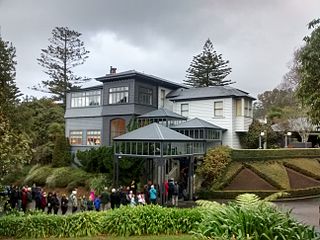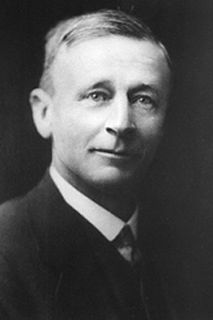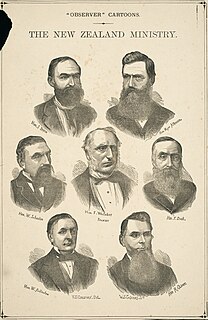
Sir Harry Albert Atkinson served as the tenth premier of New Zealand on four separate occasions in the late 19th century, and was Colonial Treasurer for a total of ten years. He was responsible for guiding the country during a time of economic depression, and was known as a cautious and prudent manager of government finances, though distrusted for some policies such as his 1882 National Insurance (welfare) scheme and leasehold land schemes. He also participated in the formation of voluntary military units to fight in the New Zealand Wars, and was noted for his strong belief in the need for seizure of Māori land.

Sir Frederick Whitaker was an English-born New Zealand politician who served twice as the premier of New Zealand and six times as Attorney-General.

Premier House is the official residence of the Prime Minister of New Zealand, located at 260 Tinakori Road, Thorndon, Wellington, New Zealand.

The 1887 New Zealand general election was held on 26 September to elect 95 MPs to the tenth session of the New Zealand Parliament. The Māori vote was held on 7 September. 175,410 votes were cast. In 5 seats there was only one candidate.

William James Mudie Larnach was a New Zealand businessman and politician. He is known for his extravagant incomplete house near Dunedin called Larnach's castle by his opponents and now known as Larnach Castle. He is also remembered for his suicide within parliament buildings when faced with bankruptcy and consequent loss of his seat in parliament.

John Bryce was a New Zealand politician from 1871 to 1891 and Minister of Native Affairs from 1879 to 1884. In his attitudes to Māori land questions, he favoured strict legal actions against Māori opposed to alienation, and he personally directed the invasion of Parihaka and the arrest of the leaders of the movement.
The following lists events that happened during 1884 in New Zealand.

Francis Joseph Rolleston was a New Zealand politician of the Reform Party.
John Christopher Rolleston was a Reform Party Member of Parliament in New Zealand.

The 11th New Zealand Parliament was a term of the Parliament of New Zealand.

The Whitaker Ministry was formed in 1882 as the government of New Zealand. It was led by Frederick Whitaker and lasted for 17 months, from 21 April 1882 to 25 September 1883. The Whitaker Ministry succeeded the Hall Ministry upon John Hall's resignation.
The Third Atkinson Ministry was a responsible government in New Zealand, sometimes referred to as part of the Continuous Ministry. It took office after the retirement of Frederick Whitaker and continued the personnel and policies of the Whitaker and Hall ministries.

Conservatism in New Zealand, though related to its counterparts in other Western countries, developed uniquely over time. Advocates followed a political ideology that emphasised the preservation of traditional European beliefs, institutions and practices.

The 1889 New Zealand Liberal leadership election was held on 6 July to choose who would lead New Zealand's parliamentary opposition and, ultimately, decide the inaugural leader of the New Zealand Liberal Party. The election was won by Wanganui MP John Ballance.
The Stout–Vogel Ministry was the second responsible government to be formed in New Zealand. It formed in August 1884 and governed until October 1887. From the outset, Robert Stout served as Prime Minister as well as Attorney-General whilst Julius Vogel held the post of Minister of Finance. Initially, the ministry lasted only two weeks, with Harry Atkinson managing to pass a vote of no confidence against Stout. However, Atkinson failed to establish his own government, and was unable to supplant Stout and Vogel who remained in power for the next three years.
The First Stout-Vogel Ministry was a responsible government in New Zealand lasting less than a fortnight, not to be confused with the longer-lasting Second Stout-Vogel Ministry. It took office after the Continuous Ministry of Harry Atkinson fell to a confidence motion after the 1884 general election.
The First and Second Atkinson Ministries were responsible governments in a period sometimes known as the Continuous Ministry. Harry Atkinson formed a government on 1 September 1876, but as it included 9 salaried ministers rather than the legally mandated 8, the Ministry was forced to resign on 13 September and take office again without John Hall. This second Atkinson ministry survived a full year.
The Hall Ministry was a responsible government in New Zealand, sometimes referred to as part of the Continuous Ministry. It took office after defeating Sir George Grey's supporters in a confidence motion, and is usually regarded as a conservative Ministry, although Hall himself described his followers as "the independent Liberal party".
The Fourth Atkinson Ministry was a responsible government in New Zealand, which lasted less than a week. It formed on 28 August 1884 after the fall of the first attempt at a Stout-Vogel coalition and lasted until Robert Stout and Sir Julius Vogel took back their majority on 3 September.









